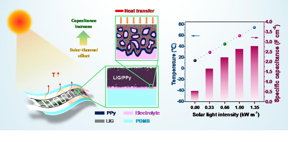Home > Press > Scientists enhance energy storage capacity of graphene supercapacitors via solar heating
 |
| Schematic diagram of fabricating process for the solar-thermal MSC and their energy storage performance under different light intensities
CREDIT LI Nian |
Abstract:
Prof. WANG Zhenyang’s research group from the Hefei Institutes of Physical Science (HFIPS) of the Chinese Academy of Sciences (CAS) has enhanced the energy storage capacity of graphene supercapacitors via solar heating. Related research results were published in the Journal of Materials Chemistry A.
Scientists enhance energy storage capacity of graphene supercapacitors via solar heating
Hefei, China | Posted on January 28th, 2022
In low temperature environments, the hindered diffusion of electrolyte ions seriously restricts the electrochemical performance of supercapacitors. Electrode materials with solar-thermal properties are expected to provide a new strategy to solve this problem. However, it remains a challenge to develop electrode materials with both excellent solar-thermal properties and high energy storage capacity.
In this research, the researchers prepared graphene films with three-dimensional porous structures using laser-induction technology. They composited the polypyrrole uniformly composited into the graphene network by pulse electrodeposition. Graphene/polypyrrole composite electrodes were obtained and a new type of solar-thermally enhanced supercapacitor was thus constructed.
This supercapacitor has many advantages. When the temperature dropped to -30 centigrade, the electrochemical performance of the supercapacitor, which is normally severely degraded, could be enhanced rapidly to room temperature under solar irradiation at light intensities of 1.0 kW m-2. Meanwhile, at room temperature (15°C), the surface temperature of the devices increased by 45°C under solar irradiation at light intensities of 1.0 kW m-2.
“After the temperature of electrodes was raised, the optimized pore structure and the increased electrolyte ion diffusion rate increased the energy storage capacity by 4.8 times. In addition, since the solid electrolyte was well protected, the capacitance retention rate of the supercapacitor was still as high as 85.8% after 10,000 times of charging and discharging,” said Dr. LI Nian, a member of the team.
This work provided new solutions for solving the low temperature problem of supercapacitors and developing high energy density devices and was supported by the National Key R&D Project of China, the National Natural Science Foundation of China, the Anhui Provincial Science and Technology Major Project, and the Anhui Provincial Key R&D Program.
####
For more information, please click here
Contacts:
Weiwei Zhao
Hefei Institutes of Physical Science, Chinese Academy of Sciences
Office: 86-551-655-91206
Copyright © Hefei Institutes of Physical Science, Chinese Academy of Sciences
If you have a comment, please Contact us.
Issuers of news releases, not 7th Wave, Inc. or Nanotechnology Now, are solely responsible for the accuracy of the content.
News and information
![]()
HKUST co-led study reveals topology at the corner of the dining table January 28th, 2022
![]()
Shining a light on synthetic dimensions January 28th, 2022
Graphene/ Graphite
![]()
Researchers uncover the mechanism of electric field detection in microscale graphene sensors December 24th, 2021
![]()
Resolving the puzzles of graphene superconductivity: Physicists publish a theoretical framework to explain the recent discovery of superconductivity in trilayer graphene December 10th, 2021
Govt.-Legislation/Regulation/Funding/Policy
![]()
Void-confinement effect of nanoreactor promotes heterogeneous catalysis January 28th, 2022
![]()
New approach transports trapped ions to create entangling gates January 28th, 2022
![]()
Acceleration of cancer biomarker detection for point of care diagnostics January 28th, 2022
Possible Futures
![]()
Void-confinement effect of nanoreactor promotes heterogeneous catalysis January 28th, 2022
![]()
Shining a light on synthetic dimensions January 28th, 2022
Discoveries
![]()
Void-confinement effect of nanoreactor promotes heterogeneous catalysis January 28th, 2022
![]()
2D materials could be used to simulate brain synapses in computers January 28th, 2022
![]()
Shining a light on synthetic dimensions January 28th, 2022
Announcements
![]()
New approach transports trapped ions to create entangling gates January 28th, 2022
![]()
Acceleration of cancer biomarker detection for point of care diagnostics January 28th, 2022
![]()
HKUST co-led study reveals topology at the corner of the dining table January 28th, 2022
Battery Technology/Capacitors/Generators/Piezoelectrics/Thermoelectrics/Energy storage
![]()
Developing high-performance MXene electrodes for next-generation powerful battery November 19th, 2021
![]()
A materials passport for greener batteries: Research project is investigating more environmentally friendly manufacturing and recycling processes October 15th, 2021
![]()
Stretching the capacity of flexible energy storage September 10th, 2021
Solar/Photovoltaic
![]()
Photon recycling The key to high-efficiency perovskite solar cells January 14th, 2022
![]()
Templating approach stabilizes ideal material for alternative solar cells December 24th, 2021
![]()
Reaction-dependent coffee-ring-regulating method in spray-coating perovskite November 5th, 2021










